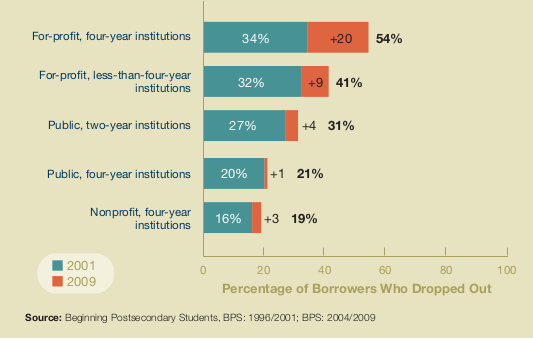Education Sector, a DC think tank, released a report last month detailing the dropout rates among student borrowers. The flashing headline was that nearly 30 percent of freshmen who borrow for school drop out prior to achieving a degree. The report also includes information about the increase in student borrowing from 2001 to 2009. The report claims that 53 percent of 2009 freshmen borrowed to attend college, up 6 percentage points from 2001. The distribution of that borrowing increase is the most interesting thing about the report:

When people generally think about students and borrowing, they think about public and non-profit four-year schools. That is what college means in the popular imagination. According to this report however, the percentage of freshmen borrowing to attend those kinds of schools actually declined from 2001 to 2009. The real drivers of the borrowing increase has been for-profit schools and, to a much lesser extent, public two-year schools, i.e. community colleges.
The story is the same for the dropout numbers as well:

The percentage of borrowers dropping out prior to degree attainment is up in all categories, but dropout levels and increases in public and non-profit four-year schools is relatively low. Even the dropout increase in public two-year schools is relatively low. The real dropout catastrophe — both in terms of levels and increases — is in the for-profit schools. Although the overall percentage of borrowers who drop out is 29 percent, the for-profit dropout levels are massively higher.
Thus, it looks like the crisis of student borrowing and dropouts is mainly driven by for-profit institutions. Many of these institutions are basically frauds set up to capture student loan money. When we talk about student debt issues however, we seem to still mainly have in mind traditional public and non-profit four-year universities. But the headline-grabbing aggregate numbers are clearly being substantially pulled up by for-profits, which still largely fly under the education reporting radar.
For me, the takeaway is two-fold. First, tackling for-profits — either reigning them in or eliminating them altogether — should be at the forefront of movements trying to help students. It is those institutions that are dumping the most extreme amount of hardship on students in terms of debt, dropouts, and poor job prospects at graduation. Second, student data of all sorts are almost completely meaningless when not divided up by institution type. As the first chart shows, student data trends can and do run in completely opposite directions for different kinds of schools. Therefore, the aggregate numbers that result from lumping all students together are both misleading and unhelpful for policy purposes.